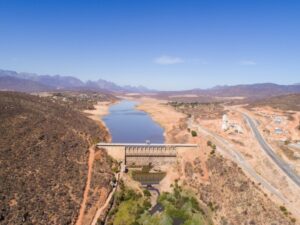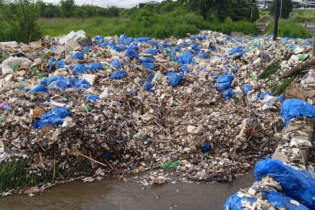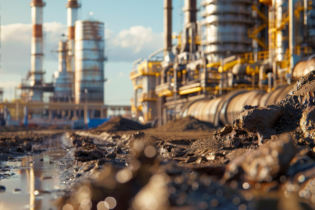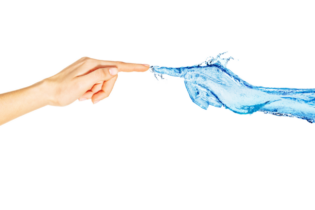Minister of Water and Sanitation – Senzo Mchunu – sat down with Kirsten Kelly to discuss municipal service delivery, key projects and of course, National Water Month.
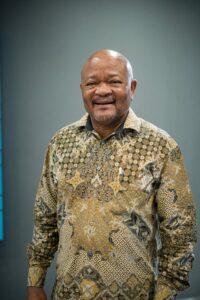 This year’s World Water Day is observed under the theme, ‘Water for Peace’, which encourages communities and countries to use water as a tool for peace, when cooperating over this shared resource. What are your thoughts on ‘Water for Peace’?
Minister: Water holds the unique duality of tranquillity and aggression.
This year’s World Water Day is observed under the theme, ‘Water for Peace’, which encourages communities and countries to use water as a tool for peace, when cooperating over this shared resource. What are your thoughts on ‘Water for Peace’?
Minister: Water holds the unique duality of tranquillity and aggression.
 Many people find solace in the presence of large bodies of water such as oceans, lakes, or rivers. The gentle sound of waves or the stillness of a serene lake can induce a feeling of peace. I was recently staying overnight at accommodation in Mpumalanga that was next to a river and the wonderful sound of the river had a calming effect on me.
Water always finds a way to flow towards gravity. Pulled by gravity, water changes its form many times as it moves from the melting snow on the mountain tops toward the sea level. It essentially flows from one neighbour to another until it reaches the sea. We should learn from water: sharing and managing resources collaboratively.
Water is powerful but unarmed. Many rivers cut across borders and have the potential to cause conflict. Water also has a violent side to it like flash floods and stormy seas. Water can be dangerous and cruel as we have seen through the 2022 KwaZulu Natal floods. Fortunately, we can mitigate the negative effects of water. We need to adjust and work around the movement of water.
But I believe that in the end, water is peace. Water can unite people and countries. I saw this at the United Nation’s Water Conference last year in New York. Here, presidents, ministers, businesses, and citizens from around the world discussed and shared water problems and solutions. There was a spirit of cooperation where people were willing to share their knowledge and help one another. Water brings people and countries together.
One fundamental change that you have made to DWS is transitioning the department from one that only concentrates on bulk water and water resource management to a department that is increasingly focussed on better supporting water services management. Would you like to elaborate?
During my orientation period in the department, I came to the realisation that we were not dealing with the value chain of water. There was a huge focus on rivers, dams and water abstraction.
But on the ground, when people protest, they seldom demanded dams or reservoirs, they want to open their taps and receive a constant supply of potable water. There is no mayor of water and sanitation, there is no municipality of water and sanitation, there is only our department and people in South Africa look to us to deal with water issues. They do not care what level of government is responsible for what portion of the water in the value chain.
When legislation was drafted, local government was given the responsibility of water provision to households and businesses, with the Minister having limited oversight.
This must change. We must go where the people are and address their needs. We must strengthen our role in regulating, supporting and intervening in municipalities where water and sanitation services are deteriorating. We have realised that community protests and complaints around water services have occurred as a result of the DWS and water boards directing their sole attention on water resource management and leaving reticulation exclusively to municipalities. Some municipalities’ capacity to supply water and sanitation to households has declined. The DWS will not abandon its focus on bulk water and water resource management but seeks to balance its priorities with water services management. Therefore, as a department, we have first concentrated on a reconfiguration of water boards to better support Water Services Authorities (WSAs).
What are the challenges with water and sanitation service delivery?
Many people find solace in the presence of large bodies of water such as oceans, lakes, or rivers. The gentle sound of waves or the stillness of a serene lake can induce a feeling of peace. I was recently staying overnight at accommodation in Mpumalanga that was next to a river and the wonderful sound of the river had a calming effect on me.
Water always finds a way to flow towards gravity. Pulled by gravity, water changes its form many times as it moves from the melting snow on the mountain tops toward the sea level. It essentially flows from one neighbour to another until it reaches the sea. We should learn from water: sharing and managing resources collaboratively.
Water is powerful but unarmed. Many rivers cut across borders and have the potential to cause conflict. Water also has a violent side to it like flash floods and stormy seas. Water can be dangerous and cruel as we have seen through the 2022 KwaZulu Natal floods. Fortunately, we can mitigate the negative effects of water. We need to adjust and work around the movement of water.
But I believe that in the end, water is peace. Water can unite people and countries. I saw this at the United Nation’s Water Conference last year in New York. Here, presidents, ministers, businesses, and citizens from around the world discussed and shared water problems and solutions. There was a spirit of cooperation where people were willing to share their knowledge and help one another. Water brings people and countries together.
One fundamental change that you have made to DWS is transitioning the department from one that only concentrates on bulk water and water resource management to a department that is increasingly focussed on better supporting water services management. Would you like to elaborate?
During my orientation period in the department, I came to the realisation that we were not dealing with the value chain of water. There was a huge focus on rivers, dams and water abstraction.
But on the ground, when people protest, they seldom demanded dams or reservoirs, they want to open their taps and receive a constant supply of potable water. There is no mayor of water and sanitation, there is no municipality of water and sanitation, there is only our department and people in South Africa look to us to deal with water issues. They do not care what level of government is responsible for what portion of the water in the value chain.
When legislation was drafted, local government was given the responsibility of water provision to households and businesses, with the Minister having limited oversight.
This must change. We must go where the people are and address their needs. We must strengthen our role in regulating, supporting and intervening in municipalities where water and sanitation services are deteriorating. We have realised that community protests and complaints around water services have occurred as a result of the DWS and water boards directing their sole attention on water resource management and leaving reticulation exclusively to municipalities. Some municipalities’ capacity to supply water and sanitation to households has declined. The DWS will not abandon its focus on bulk water and water resource management but seeks to balance its priorities with water services management. Therefore, as a department, we have first concentrated on a reconfiguration of water boards to better support Water Services Authorities (WSAs).
What are the challenges with water and sanitation service delivery?
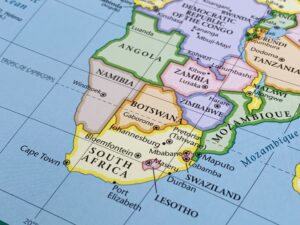 The crux of our challenge lies in ensuring that water WSAs understand their duties and responsibilities as well as the requirements for delivering efficient water and sanitation services. This is particularly difficult when there are frequent leadership changes in local government. For instance, the City of Tshwane has had four different mayors in five years while the City of Johannesburg has had eight different mayors in five years.
To arrest and reverse the deterioration of municipal water services, the Department of Water and Sanitation (DWS) is amending the Water Services Act to empower national government to intervene effectively in failing municipalities. The Water Services Amendment Bill has been approved by Cabinet for public comment. The key changes included in the Bill are a legal requirement for all water service providers to have an operating license, and an amendment to Section 63 of the Act to strengthen enforcement mechanisms.
These amendments are seeking to ensure that WSAs provide water services to an acceptable standard. We will only issue a licence to WSAs with relevant technical and financial competencies. These proposed amendments will still allow municipalities to be both a WSA and WSP, but they must have a licence to carry out the WSP function.
Where there is a persistent failure to meet license conditions, I will be empowered to enforce a separation between the role of WSP and WSA, ensuring that a capable service provider is appointed by the relevant municipality.
WSPs must comprise skilled people that manage water efficiently. Revenue received from water provision will be ring-fenced for further investment in operations and maintenance of water.
The crux of our challenge lies in ensuring that water WSAs understand their duties and responsibilities as well as the requirements for delivering efficient water and sanitation services. This is particularly difficult when there are frequent leadership changes in local government. For instance, the City of Tshwane has had four different mayors in five years while the City of Johannesburg has had eight different mayors in five years.
To arrest and reverse the deterioration of municipal water services, the Department of Water and Sanitation (DWS) is amending the Water Services Act to empower national government to intervene effectively in failing municipalities. The Water Services Amendment Bill has been approved by Cabinet for public comment. The key changes included in the Bill are a legal requirement for all water service providers to have an operating license, and an amendment to Section 63 of the Act to strengthen enforcement mechanisms.
These amendments are seeking to ensure that WSAs provide water services to an acceptable standard. We will only issue a licence to WSAs with relevant technical and financial competencies. These proposed amendments will still allow municipalities to be both a WSA and WSP, but they must have a licence to carry out the WSP function.
Where there is a persistent failure to meet license conditions, I will be empowered to enforce a separation between the role of WSP and WSA, ensuring that a capable service provider is appointed by the relevant municipality.
WSPs must comprise skilled people that manage water efficiently. Revenue received from water provision will be ring-fenced for further investment in operations and maintenance of water.The DWS will support WSAs wherever possible. We do not want to take away their duties or undermine them. But when water and sanitation services fail, we have an obligation to intervene on behalf of the people we serve.
We will not allow revenue from water to be used as a ‘slush fund’ for municipalities to waste. We are looking at municipalities like eThekwini, Tshwane and iLembe to potentially give the water service provider function to water boards. We have witnessed the reconfiguration of water boards, the revival of Blue Drop and Green Drop Reports and even the newer No Drop Reports, what else has been done to reform the sector?- CMAs and WUAs
- Pongola-Mzimkhulu in KwaZulu-Natal
- Mzimvubu-Tsitsikama in the Eastern Cape
- Vaal-Orange in the Free State, Gauteng, Northern Cape and some parts of the North-West
 We are also establishing more than 300 water user associations (WUAs). The purpose of a WUA is to enable people within a community to pool their resources (money, human resources, and expertise) to carry out water-related activities more effectively. Through a WUA, members can benefit from addressing their local needs and priorities. WUAs operate at a restricted localised level. WUAs can provide a mechanism through which the catchment management strategy can be implemented at local level. They have an important role to play in terms of poverty eradication and providing food security.
We are also establishing more than 300 water user associations (WUAs). The purpose of a WUA is to enable people within a community to pool their resources (money, human resources, and expertise) to carry out water-related activities more effectively. Through a WUA, members can benefit from addressing their local needs and priorities. WUAs operate at a restricted localised level. WUAs can provide a mechanism through which the catchment management strategy can be implemented at local level. They have an important role to play in terms of poverty eradication and providing food security.
- Pricing
- Transboundary agreements
 Furthermore, South Africa, Zimbabwe, Botswana and Mozambique who are all members of the Limpopo Watercourse Commission (LIMCOM) have signed am amended LIMCOM transboundary agreement. This will strengthen South Africa’s relations with the three riparian states which share the Limpopo River Basin and use water from the river to support various socio-economic activities including agriculture, tourism, energy generation as well as for domestic use.
What are some of the key water projects in the country?
A lot of emphasis has been placed on key priority projects – at different stages of development – that will ensure water security not only at a national level but inclusive of provinces, metros and district municipalities. I am personally visiting these projects on a frequent basis.
Furthermore, South Africa, Zimbabwe, Botswana and Mozambique who are all members of the Limpopo Watercourse Commission (LIMCOM) have signed am amended LIMCOM transboundary agreement. This will strengthen South Africa’s relations with the three riparian states which share the Limpopo River Basin and use water from the river to support various socio-economic activities including agriculture, tourism, energy generation as well as for domestic use.
What are some of the key water projects in the country?
A lot of emphasis has been placed on key priority projects – at different stages of development – that will ensure water security not only at a national level but inclusive of provinces, metros and district municipalities. I am personally visiting these projects on a frequent basis.
- Gauteng
- As Gauteng is the economic hub of the country, the revival of the Lesotho Highlands Water Project Phase 2 is very important as it will boost the province’s water supply and will help to alleviate some of its supply challenges. R40 billion in capital is required for this phase and will be raised in South Africa’s financial markets by the Trans-Caledon Tunnel Authority.
- Western Cape
- Another project that has been revived is the raising of the Clanwilliam Dam wall by 13 metres. This nearly triple the dam’s capacity and be a huge relief to farmers within the area.
- The Brandvlei Dam in Worcester will also be raised to provide farers in the area relief. This forms part of the greater Brandvlei Scheme.
- KwaZulu Natal
- The raising of the Hazelmere Dam project was recently completed at a cost of R820 million, increasing the storage capacity of the dam.
- The R23 billion uMkhomazi Water Project has been resuscitated, after being delayed for several years. This will increase water security in the uMngeni Water Supply System which supplies eThekwini, uMgungundlovu, iLembe, Ugu, Harry Gwala District Municipalities and Msunduzi Local Municipality.
- Limpopo
- Significant progress has also been made towards the R4.1 billion Giyani Bulk Water Project, with the first phase completed in 2023. This involved constructing a pipeline from the Nandoni Dam outside Thohoyandou to the Nsami Dam in Giyani.
- Olifants Water Resource Management Module (OMM Programme)
- Masodi Wastewater Treatment Works Project (nearly completed)
- Olifantspoort and Ebenezer Water Supply Schemes will be implemented in three phases over a seven-year period. This first phase of the upgrade works is envisaged to increase the availability of potable water supply to the city by between 55 Mℓ/d and 65 Mℓ/d by 2026.
- The raising of the Tzaneen Dam Project in Limpopo is expected to be completed in March 2025, at a cost of R555 million.
- Eastern Cape
- The Mzimvubu Water Project is back on track after years of delay. The project has since been reconfigured to make it more affordable, and the estimated cost has been reduced from R18 billion to R8 billion.
- Augmentation of the James Kleynhans Bulk Water Supply in Makhanda
- Free State
- Greater Mangaung Water Augmentation Project
- North-West
- The Pilanesberg Water Supply Project will supply additional treated water to Rustenberg Municipality through the construction of a pipeline, pump station and reservoir.
- Northern Cape
- Vaal Gamara Regional Water Supply Scheme which will include distribution of water to communities. The Scheme is expected to cost R 10 billion .


